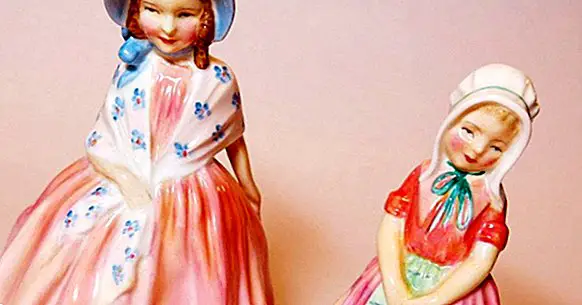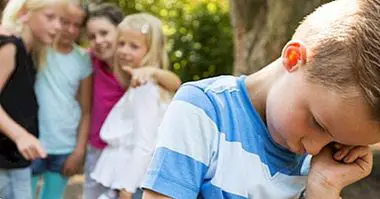Gender stereotypes: this is how they reproduce inequality
The illusion of gender equality that we are in today's society in which we think that inequality is a thing of the past or of other countries, despite the existence of gender violence (maximum expression of such inequality), the wage gap, the unequal distribution of housework and parenting, the economic and political areas that continue to be mostly male ... etc, show the continuity of this problem and the need to analyze the factors that cause and perpetuate this inequality.
At the base of gender inequality there are, among other aspects perpetuating the problem, gender stereotypes , as we will see.
- Maybe you're interested: "What is radical feminism?"
How is gender inequality inherited?
One of the theories that analyzes these aspects is the theory of differential socialization proposed by Walker and Barton (1983) that explains how people, in their process of initiation of social and cultural life and from the influence of socializing agents, acquire gender differential identities that entail attitudes, behaviors, moral codes and stereotyped norms of the behavior assigned to each gender. That is, the differential socialization based on sex generates gender inequality.
- Related article: "Causes of gender inequality: differential socialization"
This differential socialization uses the different agents of socialization to transmit stereotypes that contribute to maintaining gender inequalities. In addition, these stereotypes persist, since continue to be transmitted in the process of socialization in all stages of development.
During the primary socialization in which one's own identity is constructed, the boy or girl through family models observes how the father plays certain roles while the mother has others, at the same time it will be incorporated to a reference group according to its sex , thus building its own identity. After this initial socialization, the process of socialization continues in school (secondary socialization) at which time the differences in socialization of men and women begin to consolidate and in turn contribute to the maintenance of gender stereotypes.
In this way, belonging to one or another sexual category will determine both the differences in the identity of each as an individual as the different social realities that occur in the interaction with others. Both determinations will condition the future behavior, that is, the future life choices, and of course the subsequent professional performance.
A) Yes, the woman will assume family functions of home maintenance , care of the children and elderly people, tasks that given the differential socialization will have to reconcile with their work.
The gender schemes
The term "mental scheme" it refers to the organized structure of knowledge or information that is constructed due to the existence of a need for knowledge as an evolutionary form of adaptation to the environment. Its development and development is closely related to the processes of socialization.
Thus, when we talk about gender schemes we refer to the set of knowledge through which the shared features are organized and those that are assigned differentially to women and men.
The gender schemes, like the rest of the cognitive schemes, have an adaptive function since they provide information about the environment to face it and adapt the behaviors to it. However, all cognitive schemes, including gender, involve a process of schematization of knowledge or information with which It simplifies and you lose nuances of reality , since the basis for your organization focuses on two rules: distortion and accommodation.
Thus, authors such as Monreal and Martínez (2010) indicate that these gender schemes contribute to the maintenance of differences between men and women through three dimensions:
- Sex roles : they are the attributions that are made on the consideration of that there are quantitative differences in the realization of activities between men and women.
- Gender role stereotypes : they refer to those beliefs about what kind of activities are more appropriate or appropriate for one sex or the other.
- Stereotypes of gender traits : those psychological aspects that are attributed differentially to men and women. These three dimensions contribute to the maintenance of inequalities because the gender schemas are based on stereotypes that assume the order established in the patriarchal society.
Gender and sexual stereotypes
In scientific research prior to the seventies, sex differences based on stereotypes were considered as positive masculine characteristics attributed to man and those characteristics considered feminine, attributed to women, as negative. However, authors such as Bosch, Ferrer and Alzamora (2006) show that from the seventies onwards, this consideration of sexual differences began to be questioned and criticized due to different reasons:
- The existence of multiple investigations that yielded results in which the similarities between the sexes are greater than the differences .
- Women's access to the world of work that allowed them to demonstrate that they can perform tasks that were previously performed exclusively by men .
- The contributions of the feminist movement such as the concept of gender.
- Explanations of social learning theories or cognitivism about the sexual typing .
From these contributions, began to consider and detect the presence of stereotypes in various investigations. The term stereotype refers to the belief system about certain characteristics or attributes common to a particular group or society. Specifically, the sexual stereotype It refers to the set of socially shared beliefs that attribute certain characteristics to each person based on their belonging to one sex or the other.
The sexual stereotype understands personality traits, behaviors and occupations that are considered as belonging to women and men.
- Maybe you're interested: "15 gender prejudices in the Yang Liu pictograms"
The stereotype of the feminine
Traditionally the feminine stereotype has been shaped by characteristics that attribute inferiority to women respect to man, based on the argumentation of the moral, intellectual and biological inferiority of women.
Although this argumentation lacks a scientific basis, it is used culturally and socially in order to maintain the patriarchal system in which women continue to be considered in terms of the female stereotype, assigning them roles and behaviors typical of the private sphere, motherhood and care tasks.
Monreal & Martínez (2010) explain how stereotypes originating in earlier times and transmitted through education maintain inequality because stereotypes present a prescriptive and normative character formed in the society by which people will guide and adapt both the representation of the self as a man or woman, their identity, expectations, beliefs and behaviors.
This character of the stereotypes allows the perpetuation of the same, since in cases in which the person adjusts to the stereotype of normative gender, that is to say, to the imposed and internalized social noma, the stereotype is corroborated, and in those cases in which the person does not conform to the gender stereotype imposed will receive the "social punishment" (reprimands, sanctions, lack of affection ...).
Inequality, today
At present, the reality and the social situation have been modified through various structural changes that attempt to eliminate gender inequalities. However, the stereotypes have not been modified and adapted to the new social situation which produces a greater distance between it and stereotypes.
The gap between the stereotype and the social reality increases due to the effect of self-compliance and the strong resistance to change presented by stereotypes . Therefore, the differences between both genders continue as men and women automatically internalize their own stereotype, with the corresponding values and interests of each gender, values that will be reflected in the roles they perform.
Although stereotypes fulfill an adaptive function that allows us to know the reality and the environment that surrounds us quickly and schematically, they are characterized by attributing the feminine and masculine as two excluding groups, in a dualistic way, as two dimensions represented at opposite poles in the one that the masculine exerts its dominion on the feminine producing clear maladaptive effects.
Thus, both gender schemas and gender stereotypes produce a vision of what can be considered as a man and a woman, influencing from the identity and decisions of each person as well as his vision of the environment, society and the world.
Despite the characteristics of the aforementioned gender schemas and stereotypes, its influence is not deterministic and immovable, so by modifying the socialization process and its transmission through the agents of socialization, a process of change could be achieved with the one that adapts the stereotypes to society allowing the current mirage of equality to be a social reality.
Bibliographic references:
- Bosch, E., Ferrer, V., & Alzamora, A. (2006). The Patriarchal Labyrinth: Theoretical-practical reflections on violence against women.Barcelona: Anthropos, Editorial of Man.
- Monreal, Mª., & Martínez, B. (2010). Gender schemes and social inequalities. In Amador, L., & Monreal Mª. (Eds) Social intervention and gender. (pp.71-94). Madrid: Narcea Editions.
- Walker, S., Barton, L. (1983). Gender, class and education. New York: The Falmer Press.



















